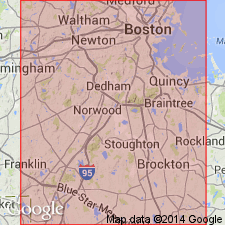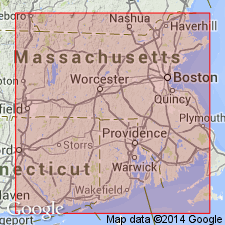
- Usage in publication:
-
- Pirate Cave Formation†
- Modifications:
-
- Abandoned
- AAPG geologic province:
-
- New England province
Summary:
Pirate Cave and Hoppin Formations are local designations for Weymouth Formation and use of these names should be discontinued. Phyllites and limestone in southeastern RI called Pirate Cave Formation by Skehan and others (1987) are lithologically comparable to, coeval with, and therefore are here assigned to the Weymouth Formation.
Source: GNU records (USGS DDS-6; Reston GNULEX).

- Usage in publication:
-
- Pirate Cave Formation
- Modifications:
-
- Named
- Dominant lithology:
-
- Marble
- Slate
- Phyllite
- AAPG geologic province:
-
- New England province
Summary:
Name Pirate Cave Formation credited to Webster (1986: M.S. thesis, Boston College). Described as a thin sequence of gray, thin-layered marbles with intercalated, maroon and bright green slates (3 m) and phyllites (15 m). Marble at base is a fine-grained and thinly layered microsparite interpreted as a mylonite. The overlying thin limestone layers and interbedded slates contain Early Cambrian hyolithids, which have been stretched and broken by deformation. Phyllites may be Middle Cambrian. Unit is overthrust by Newport Neck Formation.
Source: GNU records (USGS DDS-6; Reston GNULEX).
For more information, please contact Nancy Stamm, Geologic Names Committee Secretary.
Asterisk (*) indicates published by U.S. Geological Survey authors.
"No current usage" (†) implies that a name has been abandoned or has fallen into disuse. Former usage and, if known, replacement name given in parentheses ( ).
Slash (/) indicates name conflicts with nomenclatural guidelines (CSN, 1933; ACSN, 1961, 1970; NACSN, 1983, 2005, 2021). May be explained within brackets ([ ]).

